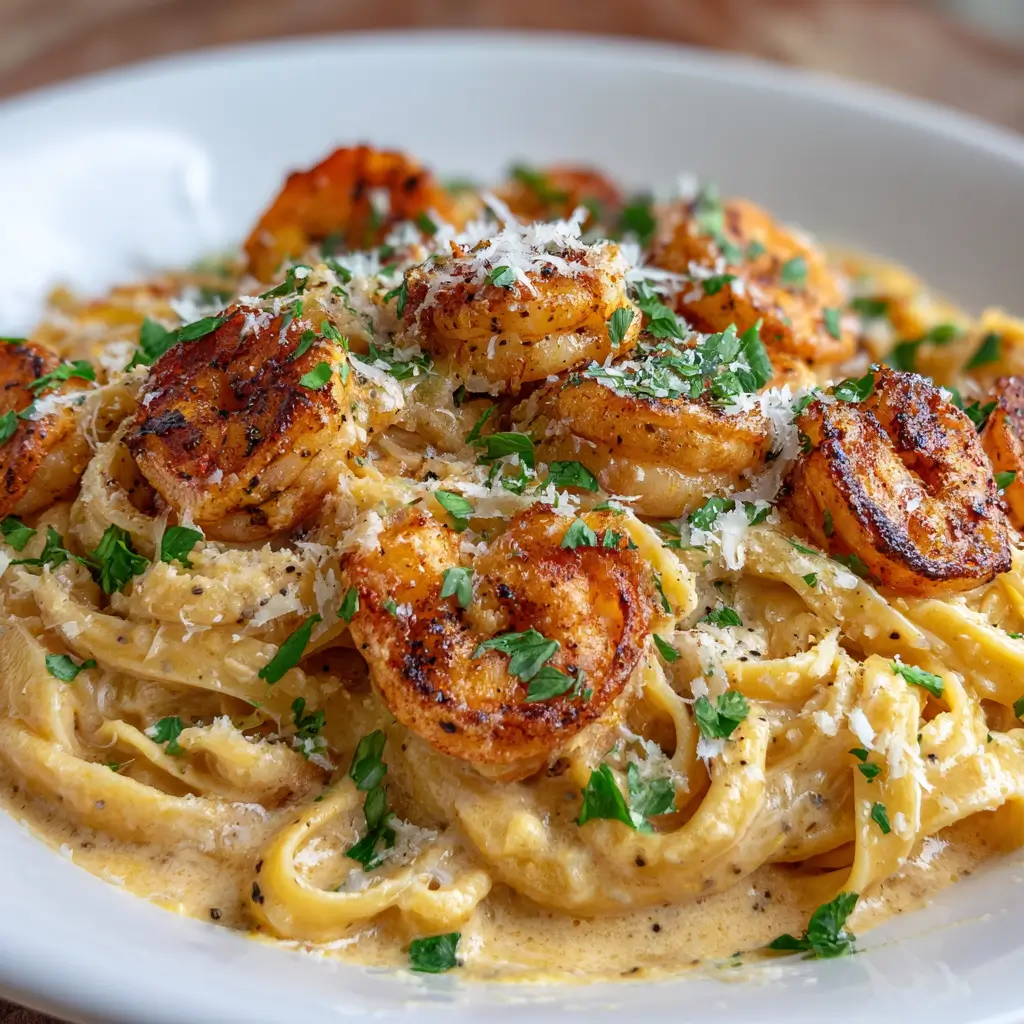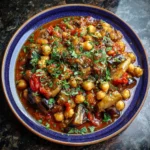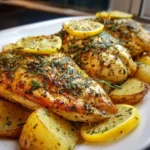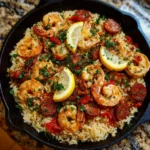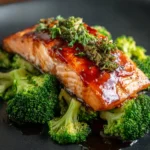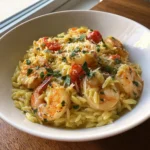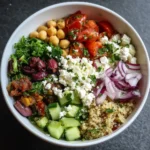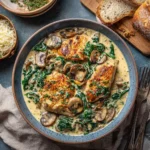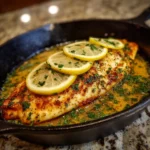Creamy Cajun Shrimp Alfredo is a luxurious fusion of bold Southern flavors and classic Italian comfort. This dish brings together the rich, velvety texture of traditional Alfredo sauce with the spicy, smoky kick of Cajun seasoning, all tied together with succulent shrimp and tender fettuccine. Whether you’re cooking for a romantic dinner, a family gathering, or simply treating yourself to something indulgent, this recipe delivers an unforgettable culinary experience that balances heat, creaminess, and savory depth in every bite.
The History
The origins of Creamy Cajun Shrimp Alfredo lie at the intersection of two beloved culinary traditions: Italian-American cuisine and Creole-Cajun cooking from Louisiana. Traditional Alfredo sauce traces its roots back to early 20th-century Rome, where it was created by Alfredo di Lelio as a simple, buttery cheese sauce served over fettuccine. Over time, especially in the United States, it evolved into a richer, cream-based version often enhanced with garlic, Parmesan, and herbs.
On the other hand, Cajun cuisine developed in rural South Louisiana among the Acadian people—French settlers expelled from Canada who adapted their cooking to local ingredients. Known for its bold spices, smoked meats, and vibrant use of the “holy trinity” (onions, bell peppers, and celery), Cajun food embraces deep flavor profiles with moderate heat. The modern twist of combining Cajun-spiced proteins with creamy pasta sauces emerged in the late 20th century as chefs began experimenting with fusion dishes that blended regional American flavors.
Creamy Cajun Shrimp Alfredo is a product of this creative culinary evolution—a harmonious blend of smooth Italian richness and fiery Southern zest. It gained popularity in restaurants across the U.S. during the 2010s, particularly in Southern and coastal cities where seafood and spice play central roles in everyday meals. Today, home cooks and professional chefs alike celebrate this dish not only for its delicious complexity but also for how effortlessly it represents American gastronomy’s melting pot nature.
Ingredients Breakdown
To achieve the perfect balance of creaminess, spice, and umami in your Creamy Cajun Shrimp Alfredo, selecting high-quality ingredients is essential. Here’s a detailed breakdown of each component:
- Fettuccine Pasta: The wide, flat noodles hold the thick sauce exceptionally well. Opt for fresh if available, though dried works perfectly too. Whole wheat or gluten-free alternatives can be used based on dietary needs.
- Large Shrimp: Peeled and deveined raw shrimp (around 26–30 count per pound) are ideal. They cook quickly and absorb flavors beautifully. You can use wild-caught Gulf shrimp for authenticity and superior taste.
- Cajun Seasoning: A blend typically containing paprika, garlic powder, onion powder, cayenne pepper, black pepper, white pepper, thyme, oregano, and salt. Homemade blends allow control over spiciness and sodium levels.
- Heavy Cream: Provides the luscious base for the sauce. Do not substitute with milk or half-and-half unless you’re okay with a thinner consistency.
- Butter: Unsalted butter gives richness and helps emulsify the sauce. Some recipes use a mix of butter and olive oil for added depth.
- Garlic: Freshly minced garlic adds aromatic pungency. Roasted garlic can be used for a milder, sweeter note.
- Grated Parmesan Cheese: Use freshly grated Parmigiano-Reggiano for maximum flavor and meltability. Pre-grated versions often contain anti-caking agents that hinder smooth blending.
- Chicken or Vegetable Broth: Adds moisture and enhances savory undertones without overpowering the dish. Low-sodium options help manage overall salt content.
- Red Bell Pepper: Sliced thinly for color, sweetness, and crunch. Green or yellow peppers work too, but red offers the mildest, fruitiest flavor.
- Onion: Yellow or white onion provides a foundational layer of sweetness when sautéed. Shallots offer a more delicate alternative.
- Cherry Tomatoes (optional): Add brightness and acidity to cut through the richness. Halved and added at the end for freshness.
- Cremini Mushrooms (optional): Sliced and sautéed for earthy depth and meaty texture, especially useful in vegetarian adaptations.
- Heavy Whipping Cream vs. Double Cream: In international kitchens, double cream may replace heavy cream; just adjust thickness with broth as needed.
- Fresh Herbs: Parsley or basil for garnish bring color and a subtle herbal lift.
- Lemon Juice: A small splash brightens the entire dish and balances the fat content.
- Olive Oil: Used for searing shrimp and preventing sticking, adding a fruity background note.
Step-by-Step Recipe
- Prepare Ingredients: Before starting, peel and devein the shrimp, mince the garlic, slice the bell pepper and onion, grate the Parmesan, and measure out all spices and liquids. Mise en place ensures smooth execution.
- Cook the Pasta: Bring a large pot of salted water to a boil. Add fettuccine and cook according to package instructions until al dente. Reserve ½ cup of pasta water before draining. Toss cooked pasta with a drizzle of olive oil to prevent sticking.
- Season the Shrimp: Pat shrimp dry with paper towels. Toss them with 1–2 tablespoons of Cajun seasoning (adjust to heat preference). Let sit for 5–10 minutes to absorb flavor.
- Sear the Shrimp: Heat 1 tablespoon of olive oil in a large skillet or Dutch oven over medium-high heat. Add shrimp in a single layer and cook 1–2 minutes per side until pink and slightly charred. Remove and set aside—do not overcook.
- Sauté Aromatics: In the same pan, reduce heat to medium. Add 1 tablespoon butter and 1 tablespoon olive oil. Sauté onions and bell peppers for 4–5 minutes until softened. Add garlic and cook 30 seconds until fragrant.
- Create the Sauce Base: Pour in 1 cup of chicken or vegetable broth and scrape up any browned bits (flavor gold!). Simmer 2 minutes to reduce slightly.
- Add Cream and Butter: Stir in 1 ½ cups heavy cream and 2 tablespoons butter. Bring to a gentle simmer, stirring occasionally.
- Incorporate Cheese: Gradually whisk in 1 cup grated Parmesan, a handful at a time, allowing each addition to melt fully before adding more. Continue until smooth and glossy.
- Adjust Seasoning: Taste the sauce. Add more Cajun seasoning, salt, black pepper, or a pinch of cayenne if desired. For extra tang, stir in 1 teaspoon lemon juice.
- Combine Pasta and Sauce: Add the drained fettuccine to the skillet. Toss thoroughly to coat every strand. If the sauce is too thick, loosen with reserved pasta water, one tablespoon at a time.
- Return Shrimp: Gently fold in the seared shrimp and any accumulated juices. Warm through for 1–2 minutes. Avoid boiling to prevent rubbery shrimp.
- Optional Add-Ins: Stir in halved cherry tomatoes, sautéed mushrooms, or spinach during the last minute for added nutrition and color.
- Garnish and Serve: Plate immediately. Top with additional Parmesan, chopped parsley, a crack of black pepper, and a lemon wedge on the side.
Tips
- Don’t Overcook the Shrimp: Shrimp turn rubbery if left too long in heat. Remove them from the pan as soon as they curl into a “C” shape—overcooking leads to an “O” shape and tough texture.
- Use Freshly Grated Cheese: Pre-shredded cheese contains cellulose, which prevents proper melting and can make the sauce grainy.
- Control the Spice Level: Cajun seasoning varies widely in heat. Start with less and add more later. Offer hot sauce like Crystal or Tabasco on the side for customization.
- Reserve Pasta Water: The starchy liquid helps bind the sauce to the noodles and adjusts consistency without diluting flavor.
- Simmer, Don’t Boil the Sauce: High heat can cause cream to separate. Keep the sauce at a gentle simmer throughout.
- Bloom the Spices: For deeper flavor, toast the Cajun seasoning in the pan with the aromatics for 30 seconds before adding liquids.
- Rest the Dish Briefly: Letting the finished pasta sit for 2–3 minutes allows the sauce to settle and cling better to the noodles.
- Double the Batch: This dish reheats well and freezes nicely (without garnishes). Portion and freeze for easy weeknight dinners.
- Balance with Acid: A squeeze of lemon juice just before serving cuts through the richness and elevates all other flavors.
- Pair with Crusty Bread: Garlic bread or baguette slices are perfect for soaking up leftover sauce.
Variations and Customizations
Creamy Cajun Shrimp Alfredo is highly adaptable to different tastes, diets, and ingredient availability. Consider these creative twists:
- Protein Swaps: Replace shrimp with grilled chicken, andouille sausage, crawfish tails, scallops, or even flaky white fish like cod.
- Vegan Version: Use plant-based shrimp (like hearts of palm or king oyster mushroom strips), vegan butter, cashew cream or coconut milk, and nutritional yeast instead of Parmesan.
- Dairy-Free: Substitute heavy cream with full-fat coconut milk and use dairy-free cheese or omit cheese entirely, relying on Dijon mustard and miso paste for umami.
- Gluten-Free: Choose gluten-free fettuccine made from rice, corn, or chickpeas. Ensure all seasonings and broths are certified GF.
- Low-Carb/Keto: Swap pasta for zucchini noodles (zoodles), spaghetti squash, or shirataki noodles. Increase healthy fats with extra butter or olive oil.
- Spice Adjustments: Make it mild for kids using “Cajun-style” seasoning without cayenne, or go extra hot with diced jalapeños or a dash of ghost pepper powder.
- Smoky Twist: Add a ¼ teaspoon of smoked paprika or a few drops of liquid smoke to deepen the flavor profile.
- Seafood Medley: Combine shrimp with crab, lobster, or mussels for a luxurious surf-and-turf Alfredo.
- Herb Infusion: Stir in fresh dill, chives, or tarragon for a unique aromatic dimension.
- Pantry-Friendly: No fresh veggies? Use frozen bell pepper mix or canned diced tomatoes (drained) in a pinch.
- Baked Casserole Style: Transfer mixture to a baking dish, top with mozzarella and breadcrumbs, then broil for a golden crust.
- One-Pan Wonder: Cook everything in a single deep skillet or pot to minimize cleanup—add pasta directly to the sauce with extra broth to finish cooking.
Health Considerations and Nutritional Value
While Creamy Cajun Shrimp Alfredo is undeniably decadent, mindful preparation can make it part of a balanced diet. Here’s what to consider:
Nutritional Highlights (per serving, approx. 1.5 cups):
- Calories: ~650–800 (varies with portion size and ingredients)
- Protein: 25–30g (from shrimp and cheese—excellent for muscle repair)
- Fat: 35–45g (mostly saturated from cream and butter; opt for lower-fat dairy to reduce)
- Carbohydrates: 50–60g (primarily from pasta; choose whole grain for fiber)
- Fiber: 3–5g (enhanced with vegetables and whole-grain pasta)
- Sodium: 800–1200mg (high due to cheese, seasoning, and broth; use low-sodium versions when possible)
- Omega-3 Fatty Acids: Present in shrimp—supports heart and brain health
- Vitamins & Minerals: Good source of vitamin B12, selenium, phosphorus, and calcium
Health Tips:
- Portion Control: Serve with a large side salad or steamed greens to increase volume without excess calories.
- Reduce Fat: Replace half the cream with evaporated skim milk or Greek yogurt (add off-heat to prevent curdling).
- Boost Nutrition: Add spinach, broccoli, or kale during the final minutes of cooking for vitamins A, C, and K.
- Heart-Healthy Swaps: Use olive oil instead of butter and limit cheese to ½ cup per batch.
- Watch Sodium: Make your own Cajun seasoning to avoid preservatives and excess salt. Rely on herbs and citrus for flavor instead.
- Allergen Awareness: Contains shellfish, dairy, and gluten. Always inform guests of potential allergens.
Ingredients
- 12 oz fettuccine pasta (or preferred noodle)
- 1 lb large raw shrimp, peeled and deveined
- 2–3 tbsp Cajun seasoning (store-bought or homemade)
- 2 tbsp olive oil (divided)
- 4 tbsp unsalted butter (divided)
- 1 medium yellow onion, thinly sliced
- 1 red bell pepper, julienned
- 4 cloves garlic, minced
- 1 cup low-sodium chicken or vegetable broth
- 1 ½ cups heavy cream
- 1 cup freshly grated Parmesan cheese
- Salt and black pepper to taste
- 1 tsp lemon juice (optional)
- ½ cup cherry tomatoes, halved (optional)
- ¼ cup chopped fresh parsley (for garnish)
- Additional Parmesan and lemon wedges for serving
Directions
- Bring a large pot of salted water to a boil. Cook fettuccine according to package directions until al dente. Drain, reserving ½ cup of pasta water, and set aside.
- Pat shrimp dry and toss with 2 tablespoons of Cajun seasoning. Set aside to marinate briefly.
- Heat 1 tablespoon olive oil in a large skillet over medium-high heat. Add shrimp in a single layer and cook 1–2 minutes per side until pink and opaque. Remove and set aside.
- In the same skillet, reduce heat to medium. Add 2 tablespoons butter and 1 tablespoon olive oil. Sauté onion and bell pepper for 4–5 minutes until soft.
- Add garlic and cook for 30 seconds until fragrant. Sprinkle in remaining Cajun seasoning and stir for 10 seconds to bloom the spices.
- Pour in chicken broth, scraping the bottom of the pan. Simmer 2 minutes to reduce slightly.
- Stir in heavy cream and remaining 2 tablespoons butter. Bring to a gentle simmer.
- Gradually whisk in Parmesan cheese until smooth and creamy. Avoid boiling.
- Season with salt, pepper, and lemon juice. Adjust heat level with extra seasoning if desired.
- Add cooked fettuccine to the skillet and toss to coat. Add reserved pasta water as needed to reach desired consistency.
- Gently fold in cooked shrimp and any juices. Warm through for 1–2 minutes.
- Stir in cherry tomatoes if using. Remove from heat.
- Transfer to serving plates. Garnish with parsley, extra Parmesan, and lemon wedges.
- Serve immediately with garlic bread or a crisp green salad.
FAQ
Can I use cooked shrimp?
Yes, but add them at the very end just to warm through. Pre-cooked shrimp can become tough if reheated too long.
How do I store leftovers?
Cool completely and refrigerate in an airtight container for up to 3 days. Reheat gently on the stove with a splash of broth or cream to restore creaminess.
Can I freeze Creamy Cajun Shrimp Alfredo?
Yes, though dairy-based sauces may separate slightly upon thawing. Stir well while reheating and add a bit of cream or butter to revive texture.
What can I use instead of heavy cream?
Half-and-half works in a pinch but yields a thinner sauce. Evaporated milk or full-fat coconut milk are better substitutes for richness.
Is this dish spicy?
It depends on the Cajun seasoning. Most blends are moderately spicy. For mild versions, use a kid-friendly blend or reduce the amount.
Can I make it ahead of time?
You can prep ingredients in advance, but assemble just before serving for best texture. Sauces can separate if held too long.
Why did my sauce break?
Sauces break due to high heat, excessive stirring, or cold ingredients added too fast. To fix, remove from heat, add a splash of cold cream, and whisk vigorously. A small amount of cornstarch slurry can also stabilize it.
What wine pairs well with this dish?
A buttery Chardonnay complements the richness, while a crisp Pinot Gris or Sauvignon Blanc cuts through the fat. For beer lovers, try a malty lager or pale ale.
Summary
Creamy Cajun Shrimp Alfredo is a decadent yet balanced dish that unites the silkiness of Italian Alfredo with the bold, spicy flair of Louisiana cuisine. Packed with flavor, easy to customize, and perfect for special occasions or cozy nights in, it’s a standout recipe that satisfies every palate.
